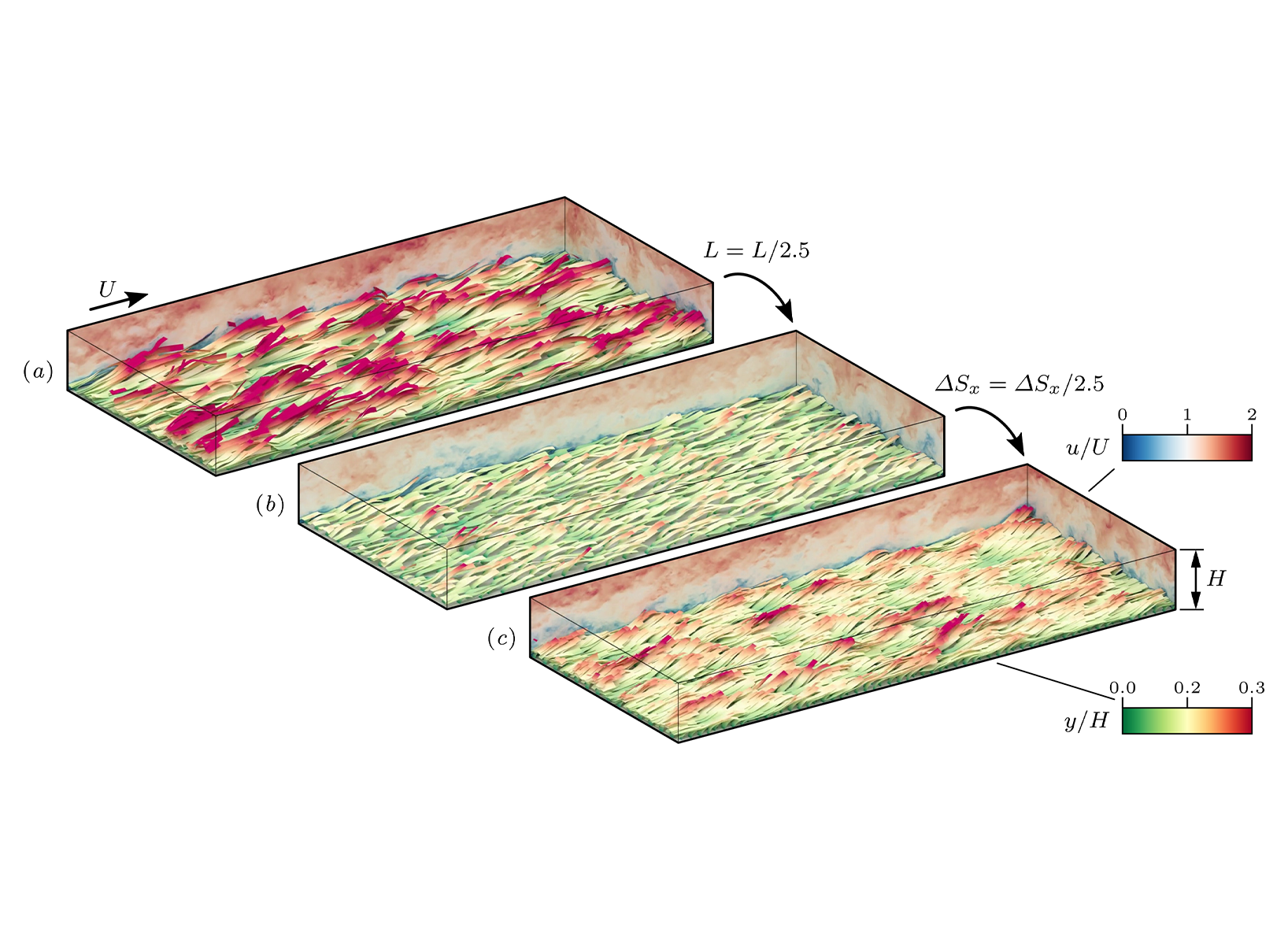Project
FSI_Canopy
In this study flows over and through modelled aquatic plant canopies are investigated to better understand the interaction between the outer flow and the interior of the canopy. This is relevant for the resistance exerted by the canopy and the exchange of oxygen, pollutants, etc. between flow and canopy. Here, very detailed numerical simulations are conducted to resolve the canopy with all individual blades with an unprecedented detail. The configurations studied are densely arranged, highly flexible ribbons, which overall represent a situation very close to real seagrass meadows, much closer than in other studies. Unexpected, for example, is the observation that the blades move quite far up-wards and even further in horizontal direction. The turbulent flow over and through modelled aquatic canopies similar to seagrass meadows is investigated using scale-resolving numerical simulations. The aim of the study is to reveal detailed information on the interaction between the flow and the flexible structures constituting the canopy.
Project Details
Project term
September 23, 2024–September 22, 2025
Affiliations
RWTH Aachen University
Institute
Institute of Fluid Mechanics
Principal Investigator
Methods
Simulations were carried out using PRIME, a code developed at the Institute of Fluid Mechanics at TU Dresden. This code solves the equations for incompressible fluid, coupled with the Cosserat rod equations that govern the dynamics of flexible structures. The fluid–structure coupling is achieved using an immersed-boundary method. Collisions between individual blades are represented by forces acting between them, obtained using a constraint-based collision model. Periodic boundary conditions were applied in the two horizontal directions to replicate the conditions in a section of a very long and wide canopy. A rigid lid condition was applied at the top boundary to model a free surface.
Results
The main results stem from a case consisting of 672 highly flexible ribbons, derived from an experimental investigation. The flow is turbulent, with a bulk Reynolds number of 20000. The high flexibility of the blades is reflected by an elevated Cauchy number of 25000. Contrary to cases with less flexible plants, as studied by the authors in a previous investigation, the movement of the ribbons, characterized by the motion of their tips, is very pronounced vertically, and even more so in the spanwise direction. The blades also twist frequently and exchange momentum by mutual collisions. Substantial interaction between the canopy and the flow was found, including an increase in drag by a factor of 12 compared to the same channel flow without vegetation. At the same time the motion of the blades is well correlated with the streamwise velocity, so that the patterns developing at the canopy–flow interface reflect the larger flow structures passing by. For these, a staggered pattern was seen to be prevalent. Conditional averages were collected to isolate events where the canopy is locally very shallow, and events where the blades are significantly more upright than on average. Thinning and thickening of the canopy is related to vertical flow over the edge of the canopy, so that this creates exchange between the portion of flow inside the canopy and the exterior.
Discussion
The present method offers a wide amount of future prospects. Ongoing evaluations address cases where the geometric properties of the blades are varied. Initial results show an impact on patterns forming in the canopy–flow interface. Another perspective is to consider canopy patches. A first such case was studied using streamwise patches and moderately stiff blades. Finally, it is interesting to consider variants where the flow is modified, since the canopy–flow interface interacts with the outer flow. One such modification is a case with sidewalls where secondary flow features related to the geometry of the channel play a role. Corresponding simulations have been conducted and are currently being evaluated.
Additional Project Information
DFG classification: 404-03 Fluid Mechanics
Software: PRIME (Phase resolving multiphase flow environment)
Cluster: CLAIX
Publications
Bastian Löhrer, Rolf Krause, Jochen Fröhlich,
A collision model for very flexible Cosserat rods and immersed-boundary fluid–structure coupling, Multibody System Dynamics
Bastian Löhrer, Jochen Fröhlich,
Large-eddy simulation of the fluid–structure interaction in aquatic canopies consisting of highly flexible blades,
https://dx.doi.org/10.1017/jfm.2025.407, 2025
F. Wollny,
Entwicklung einer automatisierten Testumgebung für den Strömungslöser PRIME,
2020
S. Tschisgale,
A Numerical Method for Fluid-Structure Interactions of Slender Rods in Turbulent Flow,
2020
K. Schoppmann,
Entwicklung eines effizienten Lösers für die Bewegung langer, flexibler Strukturen veränderlicher Breite,
2020
K.-M. Bornemann,
Numerical Investigation of Turbulent Flow over and through Inhomogeneous Canopie,
2020
Silvio Tschisgale, Bastian Löhrer, Richard Meller, Jochen Fröhlich,
Large eddy simulation of the fluid–structure interaction in an abstracted aquatic canopy consisting of flexible blades
https://dx.doi.org/10.1017/jfm.2020.858, 2021
Karl Schoppmann, Bastian Löhrer, Silvio Tschisgale, Jochen Fröhlich, Emmanuel de Langre,
An efficient solver for a Cosserat rod of non‐constant width applied to a problem of fluid‐structure interaction,
https://dx.doi.org/10.1002/pamm.202100152, 2021
Bastian Löhrer, Jochen Fröhlich,
Large eddy simulation of the flow over a canopy with spanwise patches
https://dx.doi.org/10.1002/pamm.202300256, 2023
B. Löhrer, D. Doppler, S. Puijalon, N. Rivére, J. J. S. Jerome, J. Fröhlich
River Flow 2020
https://dx.doi.org/10.1201/b22619, 2020
Thesis:
M. R. D. Brandt,
Parallelisierte Visualisierung von Wirbelstrukturen,
Bachelor thesis 2019
L. Mastrangelo,
Analysis of Splat and Antisplat Events in the Flow over Aquatic Canopies Based on Data from Large Eddy Simulations,
Thesis 2022
 Illustration of three physical models investigated, showing snapshots of the numerical solution. The three cases differ in the number of canopy elements per base area and in their length.
Illustration of three physical models investigated, showing snapshots of the numerical solution. The three cases differ in the number of canopy elements per base area and in their length.